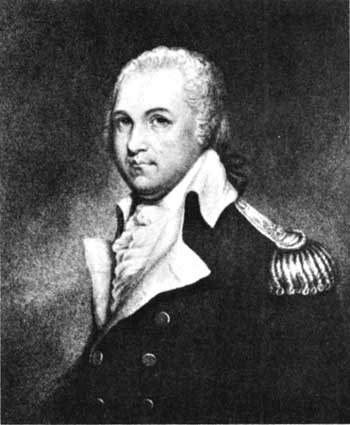|
GUILFORD COURTHOUSE National Military Park |
 |

Lt. Col. Henry Lee, familiarly known as'"Light
Horse Harry." His cavalry was used brilliantly by General Greene in the
Southern Campaign.
By J. Herring after a painting by Gilbert
Stuart. Donated to the National Park Service by Guilford Battle Ground
Company.
American Lines
Greene's troops were drawn up in three lines, approximately 400 yards apart, facing west. The first two lines extended north and south across the New Garden road; the third line was entirely north of the road, following the crest of a low hill. Heavily wooded terrain limited the effectiveness of cavalry. The woods likewise reduced the effectiveness of artillery since the field of fire, particularly for the attacking force, was poor. Approximately one-half mile in front of the position was a small stream from which the ground rose steadily, though rather gradually, to the crest of a hill where the first line was drawn up. Three cultivated fields, one to the north and two to the south of the road, provided an excellent field of fire for parts of that line, and the rail fences en closing the cultivated land afforded the troops some protection. The second line was entirely in the woods, and the third was near the eastern edge of a good-sized clearing.
Both flanks of the first two lines and the right flank of the third were unprotected. But the heavy woods dictated a direct frontal attack by the British; therefore these exposed flanks were not a disadvantage for the Americans. The left flank of the third line rested on the New Garden Road and was protected by artillery during the later stages of the battle.
The First Line consisted of two brigades of North Carolina Militia, almost all of whom were wholly untrained and entirely without battle experience. On the left flank were stationed Lt. Col. Henry Lee's Legion and Col. William Campbell's Riflemen. The former were regulars and the latter were frontiersmen from the Virginia and North Carolina mountains who had had appreciable campaign experience, including participation in the Battle of Kings Mountain. The right flank detachment was composed of Lt. Col. William Washington's regular cavalry, the remnant of the Delaware regiment of Continentals, and Col. Charles Lynch's Riflemen, comparable in experience and capacity to Campbell's. In the center on the road, a section of artillery, two 6-pound guns, commanded the stream-crossing below.
The Second Line was made up entirely of Virginia Militia, the majority of whom were as untrained and inexperienced as were the North Carolinians in the front line. The Virginia officers, however, were largely men who had served in the Continental Army, and a number of them had had some battle experience. Also in the ranks of the Virginians were a few men who had had previous military service. Thus the second line was somewhat stronger than the first by virtue of this leaven of experience. Finally, Brig. Gen. Edward Stevens, in command of one brigade, placed sentinels a few yards in the rear of his line to insure against any break by his men.
The Third Line was composed of Greene's two small brigades of Continental troops. Of the four regiments, one, the 1st Maryland, was a veteran unit. The 2d Maryland and the two Virginia regiments were recently reorganized, had excellent officers, and contained a good proportion of veterans in the ranks. The total force, regular and militia, infantry, cavalry, and artillery, numbered about 4,400. Of this total possibly 1,500 to 1,600 of all arms were regulars, but many of these fell into the recruit classification.

|

| History | Links to the Past | National Park Service | Search | Contact |
|
Last Modified: Mon, Dec 2 2002 10:00:00 am PDT |

